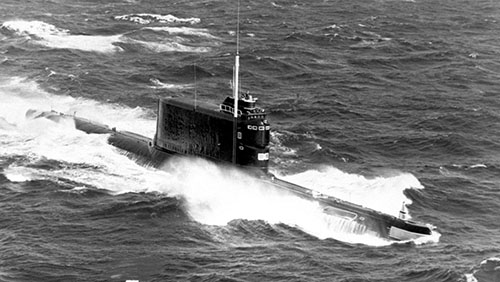North Korea has released a new video of an alleged ballistic missile launch from a submarine. The footage isn't dated, but the reporter in the video claims the launch took place last December. According to the Pentagon, the test was conducted near Sinpo, a port city located on the North Korean coast in the Sea of Japan.
The one shown, however, would be a collage of various tests, not a complete demonstration of the success of a launched SLBM. In fact, North Korea has a "new" submarine capable of carrying ballistic missiles. This would be an old, highly modified 'Progetto 629' class 'Golf'.
The 'Golf' class diesel-electric powered submarines entered service with the Soviet Union in 1958 (photo below): the 23 boats built were disbarred from active service in 1990. In 1993, North Korea bought ten ' Golf 'in scrapping. Twenty years later, the last submarine of the class has returned to sail the seas. The 'Golfs' were capable of carrying both ballistic and Scud missiles (with a single one megaton warhead), but we are talking about obsolete weapon systems: just think that the three 'R-13' missiles carried could be launched only on the surface (madness in the current strategy) at a maximum distance of 600 km. The 'R-13s' were all retired in 1975.
Just to give an example. The 'Trident II' that equip the American and British submarines have a range of twelve thousand km. Pyongyang, however, is still not in possession of the SLBM (submarine-launched ballistic missile) technology. North Korea, therefore, has an old ballistic missile submarine, but has not yet completed the development of such weapons to perform the specific nuclear deterrence service.
Despite everything, the Maritime Research Institute, responsible for research and development of North Korea's marine and submarine technology, has been developing SLBM technology for years and may even be able to perform the first (real) test launch from a submarine by 2016.
 The information currently available on the real capacity of the North Korean submarine fleet, however, remains scarce. According to official information, the fleet should consist of twenty 'Romeo' class boats, forty 'Sang-O' class boats and ten 'Yono' class mini submarines. Most of them are unable to carry ballistic missiles. On May 29, North Korea's official channels released a video of a ballistic test of a missile launched from a submarine.
The information currently available on the real capacity of the North Korean submarine fleet, however, remains scarce. According to official information, the fleet should consist of twenty 'Romeo' class boats, forty 'Sang-O' class boats and ten 'Yono' class mini submarines. Most of them are unable to carry ballistic missiles. On May 29, North Korea's official channels released a video of a ballistic test of a missile launched from a submarine.
The new 'SLBM' was presented as an immune system to Seoul and Washington's defense shield in defense of South Korea. In the video, some threatening (but typical) messages such as, for example, “only two SLBMs will be enough to wipe out Seoul ". Immediately after the video was released, the evaluations began. Meanwhile, the actual launch took place only in the last twenty seconds of the video. The first ten seconds of the launch seemed to have been extrapolated from an American video, present on the network for years, showing the ejection of the Trident-I ballistic vector 'cold'. The missile is ejected from the submerged platform by compressed air. The ignition of the first stage (thrust phase) occurs after passing the sea surface. The passage from the launch of the missile from the depths of the sea to the ignition of the vector occurs abruptly, a sign of an external intervention by a hasty direction. Probably, the second part of the video could also have been taken from another video already broadcast on YouTube (in a country that bans the internet unless you go through government-controlled channels).
Pyongyang would have sixteen nuclear warheads, by 2020 it could have one hundred. North Korea's nuclear weapons will become increasingly sophisticated, thanks to the experiments that continue to take place in the country's underground laboratories. This prediction is based on the assumption that North Korea has two nuclear facilities. The best known is the one located in Yongbyon, near the Nuclear Scientific Research Center, a major nuclear facility 60 miles north of Pyongyang. The second would have been located, while there would be three other underground sites.












